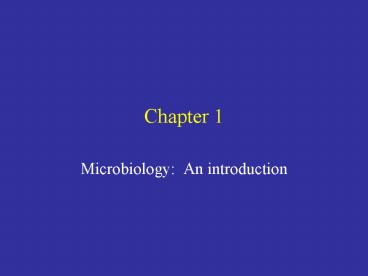Microbiology: An introduction - PowerPoint PPT Presentation
1 / 32
Title:
Microbiology: An introduction
Description:
Biochemistry to study physiology. Microscope for morphology. Different types of microorganisms ... Nutritional requirements. Biochemical activities. Sources of energy ... – PowerPoint PPT presentation
Number of Views:587
Avg rating:3.0/5.0
Title: Microbiology: An introduction
1
Chapter 1
- Microbiology An introduction
2
- What are some things that we know about the
history of microbiology and infectious diseases? - How are things similar or different today?
3
(No Transcript)
4
- Invention of the microscope to genomics
- Sequencing of the genome of different organisms
- Molecular biology
- Different infectious diseases
- Early 1900s, pneumonia, TB and gastroenteritis
were the leading causes of death - Bubonic plague, Malaria, Tuberculosis, Measles,
Small Pox, Polio - SARS, Anthrax, Lyme disease, AIDS, Syphillis
5
How are bacteria different from other organisms?
- The ability of microorganisms to exist
independently in nature - Other organisms cannot live an independent
existence - They need interactions with their environment
- In general, microorganisms are too small to be
seen with the naked eye
6
What is microbiology?
- Benefits and negative features of microbes
- Infectious diseases
- Microbes as cells
- How microbes live
- History
- Modern microbiology
7
What are microbes?
- Mostly single cell organisms
- How do we study something too small to be seen?
- Molecular strategies DNA, RNA and protein
- Cannot study a single cell look at populations
- Biochemistry to study physiology
- Microscope for morphology
8
Different types of microorganisms
- Bacteria (Bacteriology)
- Archae
- Fungi (Mycology)
- Protozoa (Parasitology)
- Algae (Phycology)
- Viruses (Virology)
- Helminths (Parasitology)
9
Bacteria will be the first organism that we
study different sizes and shapes
- Cocci Spheres
- Bacilli Rods
- Spirochettes Curved or spiral
10
Bacteria often appear in aggregates
- Pairs
- Chains
- Tetrads
- Clusters
- Microscopic appearance is valuable in
classification and diagnosis
11
Bacteria Also different staining patterns
Gram vs. gram -
12
Bacteria differ in many ways
- Shape
- Chemical composition staining patterns
- Nutritional requirements
- Biochemical activities
- Sources of energy
- Sunlight or chemical compounds
- (look at handout)
13
Importance of microorganisms
- Most microorganisms are not harmful
- Normal flora
- Very rarely harmful, mostly they help us
- Compete with the harmful biota we come in contact
with - For women, treat urinary infections with
antibiotics - May then develop a yeast infection
14
Importance of microorganisms
- Agriculture
- Energy/environment
- Disease
- Food
- Biotechnology
15
- Nitrogen fixing bacteria produce usable nitrogen
for plants to use for growth - In cattle and sheep, microorganisms carry out the
digestion of cellulose
16
Microorganisms are important in energy production
- Natural gas (methane) is a product of bacterial
activity - Waste materials can be converted to biofuels by
microorganisms - Microorganisms can detoxify unwanted wastes in
the environment
17
E. Coli is an important microorganism for genetic
engineering
18
Microorganisms can have both positive and
negative effects on food
- Food can become contaminated by microorganisms
- Food spoilage and diseases
- Food can benefit from microoganisms
- Cheese
- Yogurt
19
Cells fundamental unit of living matter
- What is life?
- Metabolism
- Reproduction
- Differentiation
- Communication
- Movement
- Evolution
20
(No Transcript)
21
(No Transcript)
22
(No Transcript)
23
(No Transcript)
24
(No Transcript)
25
(No Transcript)
26
(No Transcript)
27
Are viruses alive?
28
How do microorganisms exist?
- Microorganisms exist in nature in populations
that interact with other populations in microbial
communities. - Most of the biomass on Earth is microbial.
29
Heirarchal organization
- Individual cell
- Make up tissues in a multicellular organism
- In a unicellular organism, the cell is the entire
organism - Population
- Interacting group of individuals of one species
- Community
- All the organisms inhabiting an ecosystem
- Ecosystem
- All the organisms living within a particular area
and the nonliving, physical components of the
environment in which the organisms interact
30
Individual cell
31
Microbial ecology
- Population
- A group of related cells derived from a parent
cell - Microbial community
- Many different populations of microorganisms
- occupying the same habitat
- Ecosystem
- Communities of organisms and their natural
environment
32
How to best study microorganisms
- Pure culture
- A population of cells that all come from a single
cell - Broth or agar
- Laboratory population
- Need proper nutrient media and environmental
conditions





























![[PDF]❤️Download ⚡️ Microbiology: Clinical Microbiology Made Easy: An Introduction and PowerPoint PPT Presentation](https://s3.amazonaws.com/images.powershow.com/10076449.th0.jpg?_=20240710114)
![PDF Fundamentals of Microbiology: In-depth Introduction and Practical Guide [Print Replica] Kindle Edition Full PowerPoint PPT Presentation](https://s3.amazonaws.com/images.powershow.com/10077863.th0.jpg?_=20240712084)
